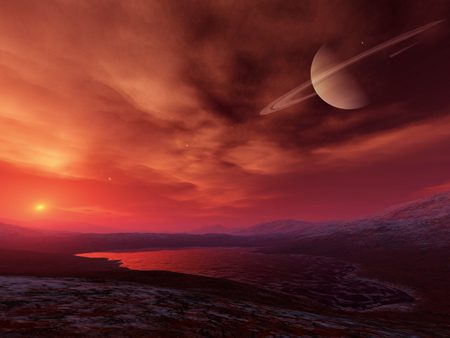The geology and climate of Saturn’s largest moon may be key in understanding our own home.

Methane laps the shoreline of one of more than 75 lakes on Saturn’s largest moon. The transparent liquid carves channels and tributaries strikingly reminiscent of lakes on Earth.
Beneath Titan’s glowing orange haze lies a frigid landscape—one once left to the imagination of scientists, whose view was obstructed by an atmosphere 10 times as thick as Earth’s. They pictured craters. They envisioned lakes—even seas—of liquid methane. But they never thought they’d find something like this.
“It’s much more dynamic than we ever thought. It’s more like Earth than anything we’ve seen,” says Jani Radebaugh (BS ’93), assistant professor of geological sciences and one of more than 30 researchers who meticulously studied the latest radar images of Titan, the largest of Saturn’s 35 moons, from data collected by NASA’s Cassini orbiter.
Their findings were published in the Jan. 4, 2007, edition of the journal Nature, which boasted images of Titan’s 75-plus methane-filled lakes on its cover. Confirming the existence of the lakes—and a weather pattern similar to our own water cycle—may be a step in understanding the formative processes behind Earth itself.
“Titan is a special place. It’s got all the right chemistry going on for the basic building blocks of life,” Radebaugh says.
She is especially attuned to the dunes gracing Titan’s surface. Sculpted out of shards of gasoline-like particles, they resemble those of the Sahara Desert.
“The dunes are the most compelling to me because we did not expect to find them there, and they turned out to be a dominant landform,” says Radebaugh. “I think they represent what planetary science is about, in that you can hypothesize and look at the evidence ahead of time and still be very much surprised by what you find in reality.”
Other resemblances to Earth’s surface strike even closer to home for Radebaugh. The size, shape, and tributaries of some of Titan’s lakes were familiar to her. “I started looking for radar pictures of Lake Powell to compare with our radar images of Titan’s lakes,” Radebaugh says. “In a way, the similarities are comforting.”
And if Los Angeles’ smoggy skies could be a comforting sight, Titan’s got those, too. That’s how Radebaugh describes the moon’s thick orange haze; a mainly nitrogen curtain that occasionally pours liquid methane in Titan’s tropical northern region.
In its liquid state, methane is colorless with a hint of a natural gas odor, hovering at about 90 Kelvin—about 300 degrees Fahrenheit below freezing. Albeit harshly colder than our own environment, Titan’s diverse setup, from the desert dunes to the “tropical” lakes, provides an introspective look into the universe at large.
“Whatever you’re learning about this new place is going to help you understand your own home better—where it came from and where we are going,” Radebaugh says. “As we continue to explore in a physical sense, we come closer to understanding the mind and will of God.”






